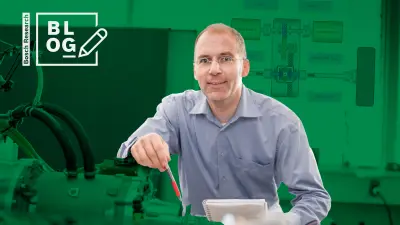How did we succeed in transferring a microphone concept from the consumer to the automotive world?
Bosch Research Blog | Post by André Gerlach, 2021-04-15

Environmental sensors are a key factor for future autonomous products. Here, humans serve as a role model for the technology. Humans perceive the environment with their senses. The senses of sight and hearing are particularly important for this. In my work, I deal with acoustics and hearing. To make a technical product hear, microphones are necessary.
We can employ microphones, but they have to become more robust
A microphone principle with particularly advantageous properties is the condenser microphone in the so-called electret version. The electret is a special plastic material that enables the conversion of sound into an electrical signal. Such microphones have been established in the consumer sector for many years. They work well, because in those applications, temperatures of over 60°C do not affect the microphone. This is also the weakness of the electret microphone. At higher temperatures of up to 95°C, as they occur in the automotive sector, the electret microphone changes its properties. The microphone function is then increasingly impaired.

With higher temperatures of up to 95°C, the function of a microphone used in the consumer sector constantly deteriorates.
Meeting the temperature challenge
Microphones become important, for example, when autonomous vehicles detect special signals from emergency vehicles. How can you design an electret that meets the increased temperature requirements in automobiles? I started my research work with a literature review. Although electret material research is very specific, you can find some literature on the subject. In particular, I evaluated literature dealing with temperature stability. In the next step, my colleagues and I built up our own electret microphones in our laboratories. We then exposed these prototypes to various tests at high temperatures. Unfortunately, the first results were not very good. The electrets we built up demonstrated deteriorated properties at higher temperatures, what a pity!
Restart with own research program
In the literature, there are hints for improving the temperature stability, but the descriptions are not so detailed that we could use them directly. Therefore, it became necessary to set up our own investigation program. All possibilities considered, such an experimental program is very extensive. In order to make a faster progress here, I have established cooperation with one of the world’s leading experts in this field. With Prof. Dr. Gerhard M. Sessler from the Technical University of Darmstadt, I have gained an excellent researcher for this collaboration. Together, we have set up the design of experiments. I have implemented this experimental program with my colleagues from our research department. Details are published in the open access journal AIP Advances of the American Institute of Physics:

Temperature resistant microphones are possible thanks to our research
As a result of our research, we have now succeeded in realizing electrets that can withstand temperatures of up to 95°C over a longer period of time. This will enable us to use electret microphones in our automotive products in the future. Such microphones become important, for example, when autonomous vehicles detect special signals from emergency vehicles. I am proud of this research result and I am looking forward to its further use.
We have succeeded in realizing electrets that can withstand temperatures of up to 95°C, which makes an application in the automotive sector possible.
What are your thoughts on this topic?
Please feel free to share them or to contact me directly.
Author: André Gerlach
André is a senior expert in the field of technical acoustics and ultrasound. His work and research area are acoustics of our Bosch products. With some products, he wants to improve the acoustics; with others, he uses sound directly for their function. André continuously develops the methods for this. For his work, he uses numerical simulations and methods of artificial intelligence. He can also characterize and visualize the acoustics through measurements in our sound measurement rooms.



